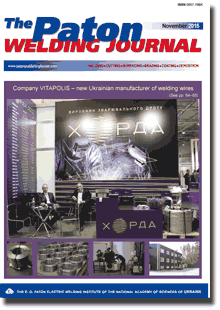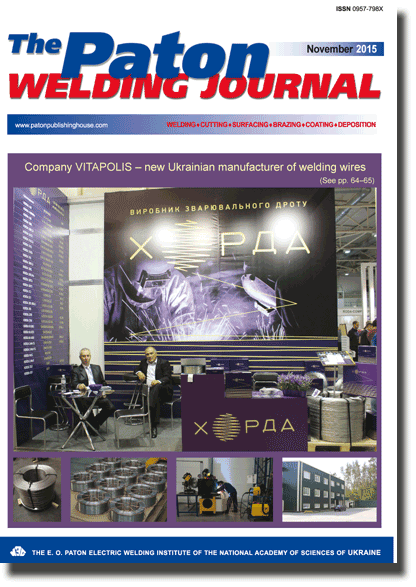| 2015 №11 (05) |
DOI of Article 10.15407/tpwj2015.11.06 |
2015 №11 (07) |

The Paton Welding Journal, 2015, #11, 48-51 pages
Evaluation of thermal stressed state in welded joint of alloy Inconel 690
N.O. Chervyakov
E.O. Paton Electric Welding Institute, NASU 11 Bozhenko Str., 03680, Kiev, Ukraine. E-mail: office@paton.kiev.ua
Abstract
The results of evaluation of thermal stressed state in welded joint of nickel alloy Inconel 690 are presented. The experimental-calculation analysis of thermal processes and mathematical modeling of stress-strain state in single-pass welding was performed. The verification of the data by comparing the experimental thermal cycles with the calculated ones showed a good similarity of results of both as to the sizes of a weld as well as to the thermal cycles in the zones at the different distance from the fusion line. The kinetics of stress-strain state in different zones of welded joint was analyzed considering the probability of hot crack formation. It is shown that under the conditions of modeling linear one-pass welding of plates of 3 mm thickness with energy input of 304 J/mm the arising stresses and deformations do not exceed the critical values and, at the same time do not create the conditions for hot crack formation. The applied mathematical model can be used in evaluation of kinetics of stress-strain state for different variants of welding (change in energy input, different filler material, etc.). 7 Ref., 1 Table, 5 Figures.
Keywords: nonconsumable-electrode arc welding, nickel alloys, thermal processes, thermal cycles, mathematical modeling, stresses, deformations
Received: 28.09.15
Published: 21.12.15
References
- (2009) Inconel® alloy 690. URL: http://www.specialmetals.com/documents/Inconel%20alloy%20690. pdf
- Kiser, S.D., Zhang, R., Baker, B.A. (2009) A new welding material for improved resistance to ductility dip cracking. In: Proc. of 8th Int. Conf. on Trends in Welding Research (Pine-Mountain, GA, 2009), 639-644.
- Nishimoto, K. (2006) Microcracking in multipass weld metal of alloy 690. Pt1: Microcracking susceptibility in reheat weld metal. Sci. and Techn. of Welding and Joining, 11(4), 455-461. https://doi.org/10.1179/174329306X94291
- Yushchenko, K.A., Savchenko, V.S., Chervyakov, N.O. (2011) Comparative evaluation of sensitivity of welded joints on alloy Inconel 690 to hot cracking. The Paton Welding J., 11, 2-7.
- Makhnenko, V.I. (1976) Computational methods for investigation of kinetics of welding stresses and strains. Kiev: Naukova Dumka.
- Yushchenko, K.A., Makhnenko, V.I., Savchenko, V.S. et al. (2007) Investigation of thermal-deformation state of welded joints in stable-austenitic steels and nickel alloys. Welding in the World, 51(9/10), 51-55. https://doi.org/10.1007/BF03266600
- Yushchenko, K.A., Savchenko, V.S., Zvyagintseva, A.V. et al. (2014) Physical-mechanical characteristics of In690 type weld in high-temperature range of ductility deep. In: Proc. of 55th Int. Conf. on Actual Problems of Strength (Kharkov, Ukraine, 2014), 189.
Suggested Citation
N.O. Chervyakov (2015) Evaluation of thermal stressed state in welded joint of alloy Inconel 690. The Paton Welding J., 11, 48-51.The cost of subscription/purchase order journals or individual articles
| Journal/Currency | Annual Set | 1 issue printed |
1 issue |
one article |
| TPWJ/USD | 384 $ | 32 $ | 26 $ | 13 $ |
| TPWJ/EUR | 348 € | 29 € | 24 € | 12 € |
| TPWJ/UAH | 7200 UAH | 600 UAH | 600 UAH | 280 UAH |
| AS/UAH | 1800 UAH | 300 UAH | 300 UAH | 150 UAH |
| AS/USD | 192 $ | 32 $ | 26 $ | 13 $ |
| AS/EUR | 180 € | 30 € | 25 € | 12 € |
| SEM/UAH | 1200 UAH | 300 UAH | 300 UAH | 150 UAH |
| SEM/USD | 128 $ | 32 $ | 26 $ | 13 $ |
| SEM/EUR | 120 € | 30 € | 25 € | 12 € |
| TDNK/UAH | 1200 UAH | 300 UAH | 300 UAH | 150 UAH |
| TDNK/USD | 128 $ | 32 $ | 26 $ | 13 $ |
| TDNK/EUR | 120 € | 30 € | 25 € | 15 € |
AS = «Automatic Welding» - 6 issues per year;
TPWJ = «PATON WELDING JOURNAL» - 12 issues per year;
SEM = «Electrometallurgy Today» - 4 issues per year;
TDNK = «Technical Diagnostics and Non-Destructive Testing» - 4 issues per year.


